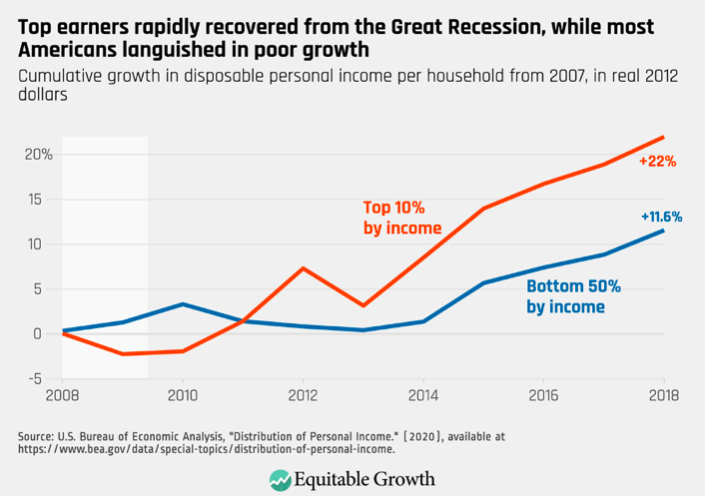The Lunacy of Never-ending Growth
This is the last of Chris Clarke’s four articles on how economic statistics deceive us. Here he considers attempts to remedy the flaws in using GDP to measure economic progress and the evolving approaches.
Inflation
At the time of writing, many governments are boasting that they have avoided recession. Remember that recession is commonly defined as two-quarters of negative GDP. Inflation is ignored in politicians’ claims.

Even ignoring inflation, Bloomberg TV has pointed out that the US has become two nations. The low-income and poor are already suffering recession. Things are different for the wealthy, whose spending continues as they prosper.

Economists measure inflation in many ways. The most common are shown below. Each has its limitations:
- CPI, the Consumer Price Index, is used at the consumer level. Economists try to define a basket of goods and services common to most consumers. Individual household spending differs by income, culture, and personal tastes.
- PPI, the Producer Price Index, attempts to measure the value of an economy's output before it reaches the consumer.
- GDP deflators assess inflation for the whole economy. They account for shifting patterns of expenditure across an entire country.
Adjusting for inflation certainly reduces the room for deception, especially concerning recessions. But GDP figures are so tainted by how they are collected and manipulated. They need to resolve the overall problem.

Purchasing Power Parity, PPP- Calculations based on this statistic also act on the deeply flawed base of GDP. They are, therefore, yet another attempt to improve on a lousy analysis. They are meant to reflect the difference in purchase costs between countries based on the variations in price for a given basket of goods. A significant issue is that the basket of goods chosen can be more or less critical to the countries being compared. For example, the US and other advanced economies often justify increases in defence budgets based on the ability of ‘enemies’ to produce weapons such as aircraft and tanks so cheaply.
There are many difficulties in such calculations. The main one is that the data compilers have a clear political agenda. A second is often the inefficiency of military spending in different countries. This is often driven by political intervention or corruption in procurement.
Can GDP calculation be more accurate?
An earlier article in this series referred to using light emissions by different countries as a measure of economic activity. Though an interesting idea, it suffers from differences in daylight hours. A focus on heavy industry or consumer spending causes variations. Culture contrasts brilliantly lit Seoul or Hong Kong with less lit Paris. High crime and security impact lighting. Some consider unnecessary lighting as environmentally harmful. The source and security of the satellite imagery might challenge the integrity of the data.

The CIA factbook – Some use this to compare economic well-being. Given the frustration caused by countries being years behind, manipulating data or poor collection quality, the CIA could be a good source of information. After all, it has comprehensive satellite information to measure crop growth. Its operatives have access to the internal data available to allies and enemies.
Political bias is the overwhelming problem. The CIA lies for a living to promote its ends. Faking imagery and data are matters of routine for such organisations.
The most significant manipulation of all
Most of us, including economists, have been brought up with variations on the following mantra. It is repeated daily across the media:
Economic growth is the best measure of human progress.
Growth based on GDP is used to demonstrate such progress.
The presenter of the YouTube series ‘Economics Explained’ (claiming 2.3 million subscribers) ends most of his short programs with an economic leaderboard. It always shows the US as the most advanced economy in the world. The size of GDP and growth are the most critical indicators of leadership. He justifies this by claiming that human wants are infinite, while productive resources are limited, so endless growth is the most crucial goal in economics.

Many in the United States and elsewhere certainly increase their consumption as their income and wealth increase. We are bombarded daily with how billionaires vie for possessing the biggest yachts or the most impressive space exploration plans. Influencers demonstrate how they consume ever more of the products and services they promote. On the other hand, many others seem content with what they have.
Are there better measures?
The previous article concluded with a link to Nobel Laureate Joseph Stiglitz’s seminal paper. It proposed better ways to measure economic progress.
Stiglitz argues that GDP is among many factors to consider when measuring well-being. The problem is that difficulties in data sources and cultural differences abound in well-being measures, just as they do with GDP. Weighting the different factors in any index is a highly subjective process.
The Human Development Index is another way of evaluating human progress.
Others use different metrics. Happiness indices are based on survey questions. The difficulty is that in some countries, saying you are happy is part of the culture, whatever problems one faces. Costa Rica is a good example. In others, saying you are unhappy can have dire consequences. North Korea is an example. Human concerns vary widely. In war or crime zones, personal safety dominates. In areas stricken by famine and epidemics, food and healthcare become priorities.

Rather than trying to weigh all these factors in creating an easy-to-criticize international index, it is better to list each item and place countries in a ranking for each. Unfortunately, there is no magic way to measure human economic development and make comparisons across countries. All measures can be criticised and manipulated.
Conclusion
Sadly, there is no happy ending. Better measures of economic performance are not yet available. The only way for anyone to evaluate human prosperity is to use as wide an array of information as possible and to question all the data we are offered, especially if it is being used to sway our political opinions or personal behaviours. Social scientists and economists always seek improvements in accurate data collection, avoiding bias and multifactor analysis. Artificial Intelligence may find patterns and predictors yet unknown.
This question should be answered, Is endless growth and consumption a valid goal? Humanity might be better served by each of us accepting less and dropping the brainwashing to consume ever more.
Next Time
We have concluded our series on how data is used to deceive us. The next article will be about the ‘new mercantilism’ and how it is destroying the remnants of capitalism and the welfare of many countries.
(Chris Clarke is a friend and former colleague. He has degrees in economics and management from the UK. He is a past chairman of the Strategic Planning Society. He worked around the globe and held leadership and partnership positions in strategic consulting, corporate finance, and advisory services. Before moving to Central America, he was based in Europe, Asia, and the US. On a pro bono basis, Chris was a visiting professor at Henley Management College. He taught senior executives in Asia and Europe. For some years, he also ran courses in M&A and corporate strategy for Management Centre Europe.)
Worked on the article:

Wanlikhang





